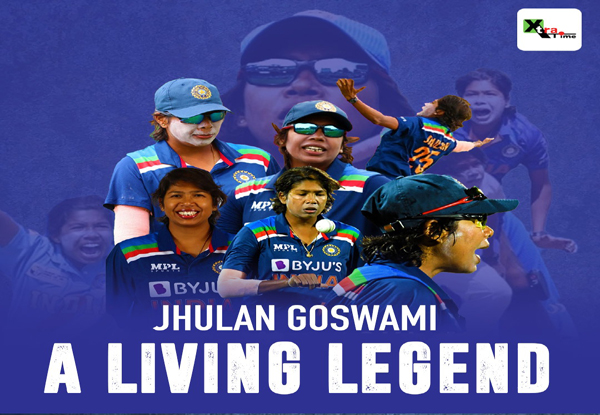
Xtra Time Web Desk:Within 24 hours there will be another emotional moment in the field of sports. A packed O2 Arena was in tears for Roger Federer’s last match in Laver Cup. There will be quite a few teary eyes as ace Indian women cricketer Jhulan Goswami bids farewell to international cricket at Lords on Saturday. A glittering career spanning almost two-decades will end for ‘Chakdah Express’.
Jhulan is set to retire at Lord’s cricket ground, after the final match of the ongoing three-game One Day International (ODI) series against England women team.
From a ball girl to becoming a trail-blazer in women’s cricket, Jhulan Goswami’s rise has been phenomenal as she inspired generations of girls in India to take up the sport. A former India captain, she is the highest wicket-taker in women’s international cricket with 353 wickets in 283 matches.
Women’s cricket in India has struggled to enjoy the same level of recognition and funding as men’s cricket. So, much of Goswami’s rise from Chakdaha, a small town in the eastern state of West Bengal, to the top of international cricket is a perfect example of what passion and determination can do.
Born into a conservative middle-class Bengali family that had no roots in competitive sport, Goswami didn’t consider the prospect of pursuing cricket seriously until the 1997 Women’s Cricket World Cup final – held at Eden Gardens in Calcutta.
She was a ball girl during the final between Australia vs New Zealand. After watching the Australian team do a victory lap at the Eden Gardens, she started dreaming of playing for India.
She made her debut in domestic cricket as part of the Bengal team towards the close of the 1990s and in January 2002, she made her international debut. In 2007, she became the first Indian to win the International Cricket Council (ICC) Women’s Cricketer of the Year Award, and took over captaincy from Raj for about three years ahead of the team’s Australia tour in October 2008. That same month, she became the first woman to be ranked number 1, when the ICC launched its world ranking system for female cricketers.
In her own admission, losing the 2017 ODI World Cup in England will be her biggest regret as the Indian women team came so close to winning the title. It was a watershed event in Goswami’s career – and in Indian women’s cricket. Jhulan’s bowling spells in the semi-final against Australia and the final against England, will be talked about for ages.
In May 2017, Jhulan went on to top the wicket-takers’ list in women’s ODIs with 181 wickets, overtaking one of her idols – Australian fast bowler Cathryn Fitzpatrick. The following February, she became the first woman to register 200 wickets in the ODI format.
She announced a surprise retirement from T20 format just three months before the 2018 T20 World Cup. She had to miss India’s last group stage fixture against South Africa at the 2022 ODI World Cup. She watched her team make an unexpected league-stage exit from the sidelines.
That could have probably prompted Jhulan to announce her retirement from international cricket. Even after her retirement Jhulu di as she is fondly known amongst her teammates will continue to inspire the next generations. All the best Jhulan Goswami.
